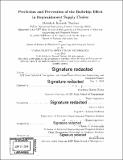Prediction and prevention of the bullwhip effect in replenishment supply chains
Author(s)
Tambat, Abhishek Ramesh
DownloadFull printable version (8.114Mb)
Other Contributors
Leaders for Global Operations Program.
Advisor
Yanchong (Karen) Zheng and Patrick Jaillet.
Terms of use
Metadata
Show full item recordAbstract
Nikes replenishment supply chain stages finished goods and materials at distribution centers and factories to provide short replenishment lead times to customers. Make-to-stock supply chains are particularly susceptible to the risks of the bullwhip effect, where demand information is distorted as it is transmitted up the chain from customers to suppliers. The information distortion leads to a sub-optimal capacity planning and inventory allocation that leads to stock-outs or excess inventory. While the literature on bullwhip analysis is rich, most of the prior work is developed based on simplistic assumption of a single stage supply chain model with only one product. These simplistic models fail to address challenges and identify relevant parameters in a complex supply chain with thousands of SKUs. Further the simplistic analysis fails to change the underlying behavior that causes bullwhip in the first place. In this work, we address all above challenges in three steps. First, we understand the inventory ordering model and the process map to identify the relevant indicators. Second, through pattern recognition, the inventory ordering patterns are clustered in three groups. We develop a hierarchical decision tree model that isolates the statistically significant features for the bullwhip effect. Finally, we team up with the stakeholders to guide their behavior towards mitigating the bullwhip effect.
Description
Thesis: M.B.A., Massachusetts Institute of Technology, Sloan School of Management, in conjunction with the Leaders for Global Operations Program at MIT, 2018. Thesis: S.M., Massachusetts Institute of Technology, Department of Electrical Engineering and Computer Science, in conjunction with the Leaders for Global Operations Program at MIT, 2018. Cataloged from PDF version of thesis. Includes bibliographical references (pages 65-66).
Date issued
2018Department
Leaders for Global Operations Program at MIT; Massachusetts Institute of Technology. Department of Electrical Engineering and Computer Science; Sloan School of ManagementPublisher
Massachusetts Institute of Technology
Keywords
Sloan School of Management., Electrical Engineering and Computer Science., Leaders for Global Operations Program.